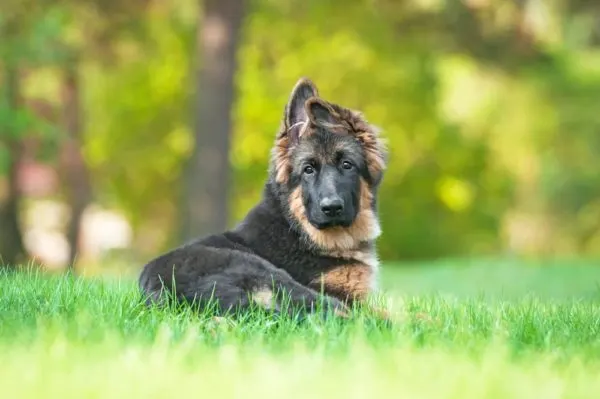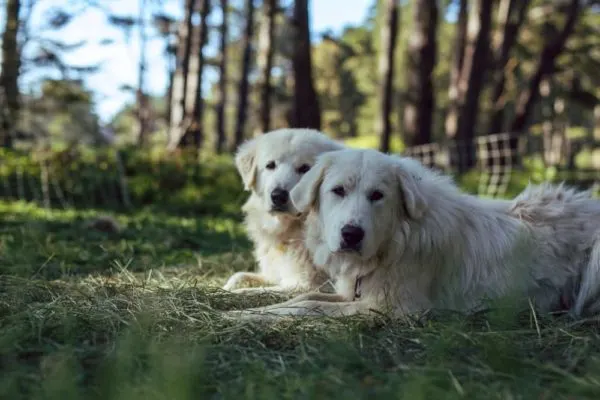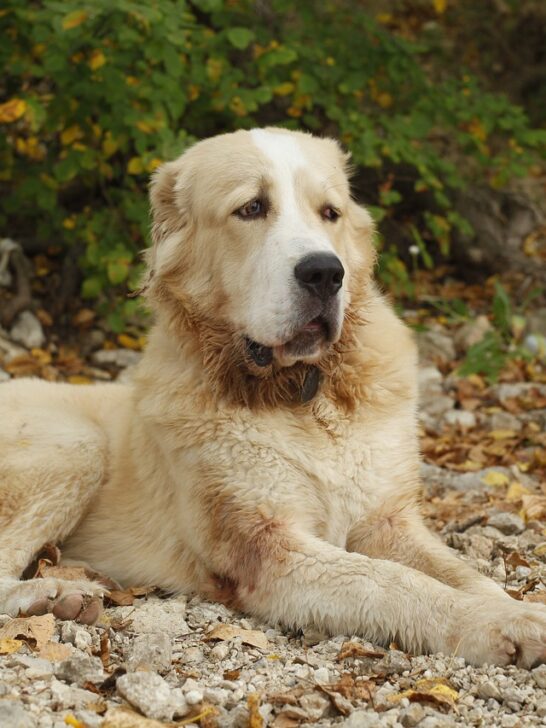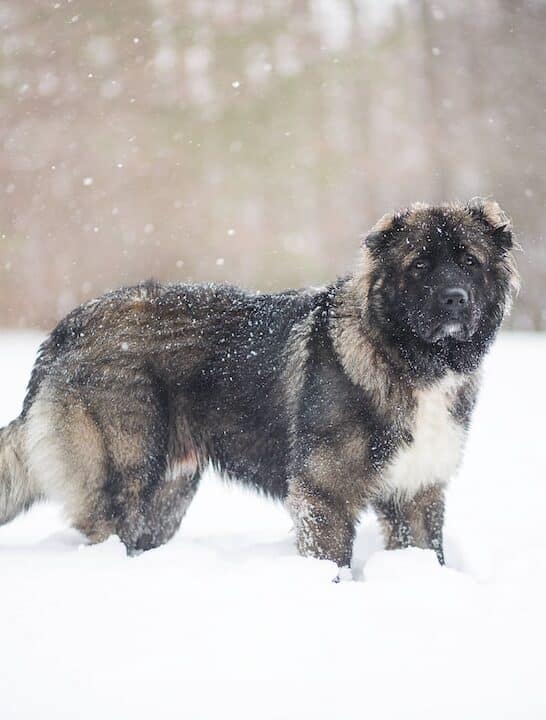Great Pyrenees German Shepherd Mix: One of the Best Devoted Family Dogs
Not all designer dogs are as predictable as the Labradoodle or Shepkita. Dogs like the Great Pyrenees German Shepherd Mix, however, are one of those hybrids that will be a lot like what you would expect.
Also known as a ‘Germanees’, this mixed intelligent breed dog is typically a balanced combination of the Great Pyrenees and German Shepherd. Although not a common mix, the Pyrenees Shepherd crossbreed possesses several qualities of a great family dog.
He is large and powerful and retains the working ability, elegance, and versatility of his german shepherd parent.
A Great Pyrenees German Shepherd Mix usually has black and tan coloring, a strong will, and a calm demeanor around other pets and children of its family. Great Pyrenees German Shepherd also tends to be affectionate and has natural guarding instincts.
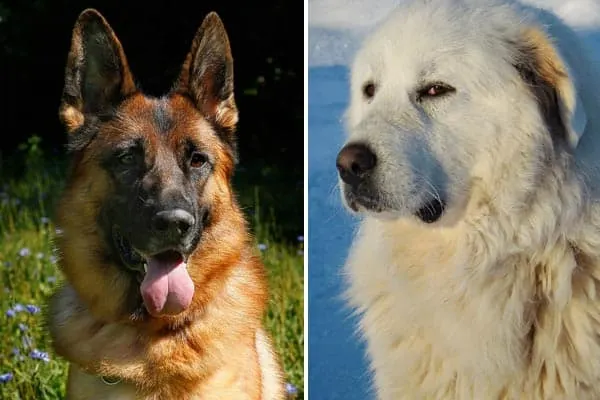
When was the first Great Pyrenees German Shepherd Mix born?
We are not sure why the Great Pyrenees German Shepherd Mix originated or exactly when. Most likely, breeders founded the Great Pyrenees Shepherd as a companion dog to secondarily protect the household. The Pyrenees German Shepherd Mix probably originated in the US after the 1990s.
Scientists are reasonably confident about the history of the founding dog breeds.
Great Pyrenees
Historians think the Great Pyrenees arrived in the mountains from whence they received their name by 3,000 BC. They likely originated from white livestock guardian dogs that lived in Asia in 9,000 BC.
The large white dogs developed in the Pyrenees Mountain Range of Europe between France and Spain largely under the Basques. Their primary duty was to guard flocks against large predators. They also served as loyal companions when not actively working.
The Great Pyrenees suffered three devastating setbacks from events that similarly affected other dog breeds.
The decline in predators, especially wolves, in the 1800s – Eliminated the need for the Great Pyrenees; France undertook restorative efforts for the Pyrenees in 1907
World War I – Afterwards, Monsieur Senac Lagrange headed breed restoration and established a breed standard in 1927
World War II and German occupation – Monsieur Senac Lagrange reestablished the Great Pyrenees breed once again at the end of the war.
The Great Pyrenees, classified as a working dog by the AKC as of 1933, is mostly a companion dog. You can easily see his influence in adding size and temperamental stability to mixed breed dogs and designer dogs such as the Germanees.
German Shepherd
The history of the German Shepherd Dog is a familiar but relatively new one. A German Shepherd type was likely in existence as early as 700 AD.
However, a breed standard officially separating the German Shepherd from other shepherd dogs of surrounding regions did not happen until 1899.
Hektor Linksrhein or Horand von Grafrath, discovered by Max von Stephanitz on the show circuit, was a Thuringian Shepherd. A careful breeding program stamped Horand’s offspring with a signature look.
German Shepherds resembled wolves in form but had enough differences to appeal to the public as pets and working dogs.
Stephanitz selected even more superior working dogs having better working qualities in the gene pool by adding dogs from the Wurttemberg and Swabian regions of Germany.
While German Shepherds avoided declines from loss of purpose, they suffered hits to their popularity with the anti-German sentiment after World War II. The German Shepherd also came under fire at various periods due to several perceptions many dog owners held.
- Hereditary health problems – Especially hip dysplasia, elbow dysplasia, and degenerative myelopathy
- Conformation exaggeration of show lines – Steep croup, extreme hind leg angulation, unsightly dysfunctional gait
- Temperament problems – Hyperactive, anxious, excessively aggressive, neurotic
German Shepherds have proven resilient and remain no. 2 in popularity in the United States for their loyalty, classic look, guard dog status and versatility.
They also are highly available as mixes as a guard dogs. Many owners seek the German Shepherd’s influence of athleticism and intelligence on designer dogs.
Great Pyrenees contribute more than size and strength
The Great Pyrenees is a calm and confident dog who can spring into action when necessary. She passes size, intelligence, alertness, and patience to her mixed breed puppies.
What looks can your puppy get from the Great Pyrenees Dog?
The Great Pyrenees is a large and impressive dog. Males are 29 to 32 inches tall and weigh over 100 pounds, with females about 10 to 15% smaller. Their heavy musculature is apparent even under a dense double coat.
Great Pyrenees dogs, unlike Mastiff-types, are substantial without being massive. They are slightly longer than tall with a long plumed tail. The Pyrenees carries her tail in a circle over her back when active.
A Great Pyrenees will not give your mixed breed puppy or mixed breed dogs a large head. The Great Pyrenees has a wedge-shaped head rounded at the top and in balance with her body.
Her coat should be mostly white, and her lips and nose black. Her eyes are brown while the ears are triangular, medium-sized, and hanging.
The Great Pyrenees mixed breed moves with surprising grace as well as power and purpose. He has balanced coordination at all gaits, contrary to the lumbering stride of other large breeds.
Great Pyrenees are universally white. They may have gray, tan, reddish-brown, or badger markings around the ears, face, and sparingly on the body. Badger is agouti coloration, featuring banded hairs that may appear black until closer scrutiny.
Similarly to white German Shepherds, Great Pyrenees have a recessive “e/e” gene that prevents black pigmentation in the fur.
They also likely have a gene modifier specific to the breed that suppresses reds and browns. The modifier ensures all dogs with “e/e” are white rather than red or yellow.
Where color suppression fails, you will see small patches of color bleed through, most commonly around the ears.
Unlike the situation with the German Shepherd, flock tenders selected for white livestock guardian dogs because the working canids could live with the sheep as an accepted member of the fold. White dogs also stood out from wolves.
Livestock guardian owner philosophy directly contrasted with the belief of tenders who owned German Shepherds.
Herders with the German Shepherd felt their dogs should be dark to intimidate, control, and command respect from the sheep.
What are the exercise requirements?
Great Pyrenees require 20 to 40 minutes of exercise daily, according to Hill’s Pet. As livestock guardians, Great Pyrenees mostly engaged in moving with flocks and brief and sporadic events of guarding and territorial posturing. They do not have the energy levels of many of the herding breeds.
What should you know about intelligence?
The Great Pyrenean Mountain Dog’s smart and independent thinking requires early and assertive training.
The Great Pyrenees ranks 64th in working intelligence, according to Dogbreedslist interpretation of the famous Stanley Cohen study. Cohen considers the Pyrenees breed average in trainability between the Old English Sheepdog and Saint Bernard.
Is the great Pyrenees a good family dog?
Other Pets
Great Pyrenees are generally kind and patient with other pets in the household. Their ancestry sets them up to get along well with multiple species.
According to Gpcgc.org, a rescue group with considerable experience with the Pyrenees, dogs can show same-sex aggression with others of their breed.
Children
The Great Pyrenees is a gentle and calm dog with household members, showing particular patience for children. Since the Great Pyrenees is such a large dog, you shouldn’t leave any small child unsupervised with your pet.
Strangers and Guests
Great Pyrenees can be moderately territorial and protective. Their devotion and instinct for guarding family make them good for protection work. However, they have a calm and discerning nature.
Most Great Pyrenees will be polite and even friendly with strangers. Their demeanor only changes if they perceive a threat. Ongoing socialization is paramount to having a Great Pyrenees that is pleasant around your visitors.
What are grooming needs?
As you would expect of a mountain-dwelling dog, the Great Pyrenees has a double coat that protects him from the frigid cold.
His dense woolly undercoat is excellent insulation again moisture and wind on the skin. Medium-long outer hairs can be straight or wavy, and further protection from wind as well as snow.
Dogs with double coats also receive protection from heat and ultraviolet light. You can ensure your dog’s coat functions at optimal levels for circulating air by brushing it regularly. The Great Pyrenees is only mildly prone to tangling and matting.
You can brush most Pyrenees once or twice weekly. During the heavy seasonal shedding of underfur, you may have to brush your dog every day.
How is Great Pyrenee’s health?
The Great Pyrenees has a lifespan of 10 to 12 years. Her most common health problems are hip dysplasia and kneecap instability or luxating patellas. Although generally healthy, the Pyrenees can also suffer from a few other issues.
- Gastric bloat and torsion – GDV
- OCD – Abnormal cartilage from growth abnormalities
- Cataracts
- Retinopathy
- Bone cancer
- Ear infections
- Skin allergies
The German Shepherd Dog is more than a pretty face
With the German Shepherd and Great Pyrenees, your mixed breed puppies will turn out attractive. Great Pyrenees’ parent makes the puppy attractive. However, the German Shepherd parent adds stamina, athleticism, and working intelligence.
What do Shepherds contribute to appearance?
German Shepherds are more closely related to the Great Pyrenees than you might think but differ dramatically in appearance.
The German Shepherd is more rectangular than the Pyrenees, both shorter at the shoulders and relatively longer from the withers to hips.
Her unique conformation allows the German Shepherd to have a ground-covering, effortless, elegant trot, and tremendous speed at the gallop.
The average German Shepherd is 22 to 26 inches tall and weighs 50 to 90 pounds. Females are generally slightly smaller than males and less muscular. The head is noble in profile with a slight dome of the forehead, long but strong muzzle, and upright ears.
Except in dilute-colored dogs, the eyes of a Shepherd are dark, and the lips and nose black. White dogs also have black noses and lips. German Shepherds have tails similar to the Pyrenees with a length to the hocks and a bushy appearance.
German Shepherds have a short, medium, or long, dense double coat that can have a range of colors.
- Black and tan – The signature look of American show lines when a saddle is present
- Mahogany and tan – The saddle pattern is common in German show lines.
- Sable – Black or wild (red) sable can occur; Dark sable is a common color of East German and Czech working lines
- Black
- Bicolor – Minimal tan markings
- Panda – Genetic mutation; Any color dog, usually black and tan, with substantial white markings
- Blue – Dilution of black; blue and tan, solid blue, or blue bicolor
- Liver – Recessive gene; Liver and tan, solid liver, or liver bicolor
- Isabella – Dilution of the liver; Isabella and tan, Isabella bicolor,
- Black and silver – Probable effects of an intensity gene on the dog’s normal tan markings turning them cream-colored
- Solid white – Masking gene, no albinism, and not a white spotting gene. White dogs have two recessive genes at the “E” color locus that prevent black expression. However, white German Shepherds have genetic markers for other coat colors. For example, a white Shepherd can be genetically black and tan but the “e/e” genes will override any color expression.
Most commonly, German Shepherds have a medium or short coat. Long-haired dogs occasionally have no undercoat.
German Shepherds have high exercise needs.
If you had a purebred German Shepherd, she would require two hours or more exercise daily. You also would have to address her intellectual need for mental enrichment and emotional demand for attention and interaction.
What makes the German Shepherd so smart?
German Shepherds rank high in working intelligence, only topped by the Border Collie and Poodle. Many people mistake intelligence and obedience to trainability. While German Shepherds are obedient, their cooperation is not unconditional.
Loyal and affectionate with their owners, proper training of the German Shepherd depends on mutual respect and consistency from their handler. Often, inexperienced pet owners do better if they enlist help from a professional trainer.
The German Shepherd can be an excellent family dog.
Other Pets
Ideally, German Shepherds should live in your house as a single pet or with another dog of comparable size.
A German Shepherd you raise with other pets usually coexists peacefully with those animals and even learns to protect them.
However, individuals may have a predatory drive that overrides their protective instinct towards small animals. Some Shepherds will be gentle with the family cat but will run down the neighbor’s prize Persians.
Another characteristic to be aware of is that some German Shepherds see other dogs of the same gender as rivals and will fight them. Unneutered males and females have a heightened tendency to show dog aggression.
Children
German Shepherds should get along well with children. Shepherds often see your kids as worthy of protection but may show the same wariness towards unfamiliar children as they would any other stranger. Socialization will help your German Shepherd not mistake children for prey.
Shepherds should never be alone with young children because of the breed’s size and high activity level.
Some German Shepherds herd young children, although not to the extent of other traditional herding dogs like the Border Collie. Your Shepherd is more likely to try and boss or control small kids.
Guests and Strangers
Polite aloofness is an acceptable part of the German Shepherd’s demeanor towards strangers, according to the AKC standard.
Some German Shepherds are friendly, while others are more suspicious of visitors. Many warm up to people in your circle of friends, but others remain distant towards anyone but family.
Socialization is a vital part of preventing your German Shepherd from becoming indiscriminately aggressive or dangerous.
Your Shepherd’s natural guarding instinct makes her an ideal candidate for formal protection training.
Misguided guard training can ruin your dog’s ability to identify threats and exercise reasonable restraint in attacking appropriately. Most pet German Shepherds have enough protectiveness without any additional training.
Grooming requirements are moderate
Just like the Great Pyrenees, the German Shepherd’s double coat protects her from the harsh elements and insulates her against both cold and warm conditions.
German Shepherds shed copious amounts of underfur twice a year. During massive sheds, a Shepherd needs you to brush him every day.
Otherwise, Alsatians require brushing two or three times a week. German Shepherds are more heat tolerant than the Great Pyrenees.
What do Shepherds contribute to health?
A German Shepherd usually lives about 10 to 13 years. Some of their more common problems are hip and elbow dysplasia, panosteitis, low thyroid function, degenerative myelopathy, GDV, and pannus. Pannus is an eye ailment from an inflammatory process in the cornea.
What should you know about the Pyrenees German Shepherd Mix?
What will your Great Pyrenees German Shepherd Mix look like?
Your Great Pyrenees German Shepherd Mix will be a large dog, standing from 26 to 32 inches tall and weighing 85 to 120 pounds.
She will be slightly longer than tall with upright or floppy ears. Her eyes will be brown, and she will have a black nose and lips.
Expect your puppy’s face to be slightly broader and rounder than a Shepherd’s with a longer muzzle than a Pyrenees’. She will have a long plumed tail that she may carry in a circle when active.
Your Germanees will likely have a short to medium-long, dense dual coat. He is most commonly black and tan, brown, black bicolor, shaded sable, cream, or white.
Solid and bicolor dogs can have varying degrees of white that you would not ordinarily see in a purebred German Shepherd. You will not see pluming of the tail on a short-haired dog.
How much exercise should you plan?
Your Great Pyrenees German Shepherd Mix needs at least an hour of exercise per day. You can meet daily requirements with about 20 minutes of high-intensity activities, 20 minutes of slow exercises like walking, and 20 minutes between training and socialization.
Great interactive exercises for the Germanees that incorporate mental stimulation and physical exertion are Shutzhund, agility, and search and rescue.
Will your dog be smart?
Your Pyrenees German Shepherd Mix puppy will be bright and quick to learn but will also be stubborn, independent, and pushy. The Great Pyrenees German Shepherd Mix does best with a self-assured person who is patient and persistent.
As with all dogs, the Germanees performs best with a positive reward system. You can utilize food treats, verbal praise, toy rewards, or any combination thereof.
Is the Great Pyrenees German Shepherd a good family companion?
Other Pets
Your Great Pyrenees German Shepherd Mix should do well with other household pets with conscientious socialization. This Pyrenees German Shepherd Mix should enjoy playing with other dogs.
You will need to watch your Shepherd mix with smaller animals because of her size and strength. You must be especially vigilant with the rare dog who may have a high prey drive.
Children
With German Shepherd and Pyrenees qualities, your Great Pyrenees German Shepherd Mix will be celebrated with the children of the household. Your dog will probably exhibit a patient and protective nature towards your children with a propensity for playfulness.
Strangers and Guests
Just because your Pyrenees mix is calm, do not expect her to be immediately accepting of strangers. Your puppy will love everyone, but once she grows up, she will probably become more protective.
Proper socialization is essential so she can learn who is a friend and who is up to no good. If you raise your Germanees with exposure to numerous people and situations, she should be wary of strangers but willing to warm to your friends.
Grooming is not too painful
Your Pyrenees Shepherd mix will require you to brush him once or twice a week. You will have to increase your brushing when your dog replaces his undercoat, usually twice a year. Limit baths to every four to six weeks since they can make your dog more prone to skin dryness and sensitivity.
A slicker and pin brush are good for your dog’s outer coat. You could consider a rake or deshedder for the thick undercoat.
Like with any dog, you should clip your hybrid Shepherd’s nails every four to eight weeks and check his ears for any sign of infection multiple times a week. Pay particular attention to dewclaws as your dog could have two on the rear legs.
The Great Pyrenees German Shepherd Mix is generally healthy
There are a few problems your Germanees could inherit from either or both parents. Your dog should live for 12 or 13 years.
- Hip dysplasia
- Retinopathy
- Skin allergies
- Panosteitis – Bone inflammation of large-breed puppies, possibly from overnutrition
- GDV – Large deep-chested breeds more vulnerable
Frequently Asked Questions
How big will a German Shepherd Great Pyrenees mix get?
You can expect your German Shepherd Great Pyrenees mix breed to grow to around 32 inches tall. This measurement is taken from the bottom of their front foot up to the tip of their years!
This is around the maximum average height you can expect. Some of them are a little under this. In fact, anything from around 22 inches and above is normal for a full size German Shepherd Great Pyrenees mix breed.
With this in mind, you can expect your German Shepherd Great Pyrenees mix to look like large dogs and should be expecting a giant breed, for sure! As well as this, you may be wondering how heavy they will get! Well, we are here to tell you that the German Shepherd Great Pyrenees mix can grow up to be a chunky boy or gal. This mix is called sweet and gentle giant for these reasons.
Your German Shepherd Great Pyrenees mix breed can weigh anywhere between 75 lbs to a whopping 120 lbs at its fully grown size…and that is just their average size!
It is pretty common to find them weighing up to 150 lbs, especially if they have a penchant for snacking and are a little on the lazy side!
How much does a German Shepherd Great Pyrenees mix cost?
The price of a German Shepherd Great Pyrenees mix may well depend on the breeder. However, you can typically expect them to range from around $400 to $500.
You should be willing to spend at least this amount on a puppy from a good, reputable breeder. You may also be able to find a German Shepherd Great Pyrenees mix in the shelter so you can adopt them!
How long do Great Pyrenees German Shepherd Mix live?
Typically you can expect a Great Pyrenees German Shepherd Mix to live for around 12 years! This is a really good life expectancy for a dog. Bigger dogs tend to have a longer life expectancy than smaller dogs.
Of course, this may not always be the case and certainly isn’t a hard and fast rule.
It is far more important that you make sure your Great Pyrenees German Shepherd mix has a long and healthy life. You can ensure this by providing them with everything they need rather than just expecting them to live that long on their own.
What we mean by this is that life expectancy estimates mean nothing if your dog is not well looked after. The Great Pyrenees and German Shepherd Mix breeds need lots of exercise and a good diet with all the nutrients they require. They will need to be groomed and kept entertained.
This will boost their life expectancy. You should also bear in mind that ‘12 years’ is not a guarantee, this is especially true of dogs that have genetic conditions or illnesses.
Summary
Figuring out if any breed or Pyrenees German Shepherd Mix is a good fit for you requires due diligence from you. Even with designer dogs, you should try to inform yourself about potential health problems and temperament. Seeing at least one of the parents helps.
Conscientious breeders should have records of ancestry and hip and eye certificates on the parents where relevant. The AKC keeps a list of tests certain breeds should undergo and gives breeders the option to register their dogs’ results.
Cautions with the Great Pyrenees German Shepherd Mix
- Potential hip or eye problems
- Oversized dog
- Somewhat difficult to train
- Destructive if left alone or if she does not have a meaningful purpose
- Public perception – Aggressive dog
- May bark excessively
What You Will Love About the Great Pyrenees German Shepherd Mix
- Affectionate and devoted
- Protective – Good natural guard dog
- Intimidating to intruders
- Not as active as the German Shepherd
- Soothing presence yet alert
- Attractive
- Can be playful
- Good at dog sports – Agility, Shutzhund
- Smart
This puppy shows one of the most frequent appearances for a Great Pyrenees German Shepherd Mix. Note the black and tan color, elegant movement, and tail carriage. The face is shorter than a Shepherd’s with semi-drop ears.
This puppy is black and tan or perhaps even a shaded sable. Note the degree of white which you would not typically see in a German Shepherd. The ears are floppy.
In young German Shepherd puppies, the ears can eventually stand up, but in this puppy, the ear set and shape suggest they will remain hanging.
Finally, you can see the length of the tail and the way it makes almost a complete circle when the dog engages in play. The tail set is characteristic of a Great Pyrenees. Shepherds can also carry their tails rather high when working but not in a circle.














